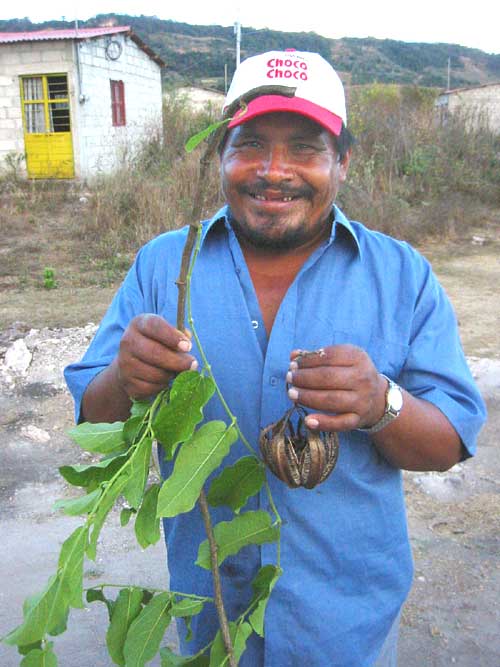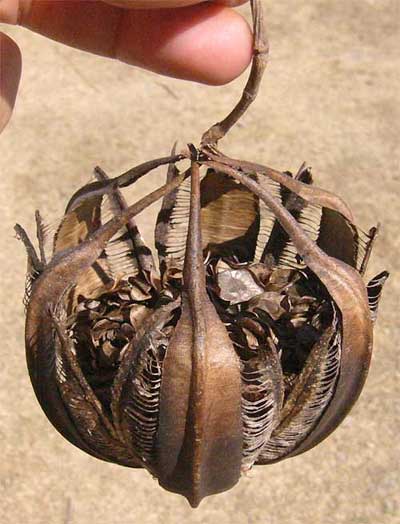from the February 18, 2008 Newsletter written in the community of 28 de Junio, in the Central Valley, 8 kms west of Pujiltic, Chiapas, MEXICO
DUTCHMAN'S PIPE FOR UPSET STOMACH
After three days of drinking the piped spring-water I developed an upset stomach, a mild diarrhea and a complete loss of appetite. It wasn't like any reaction I'd ever experienced to water or food contamination so I'm still unsure whether it was the water that caused my problems. A flu-like thing has been going around in the highlands so maybe I had that.
When my friend Antonio heard that my stomach was upset, about half an hour later he thumped on my door and there he stood holding some goodies, as shown below:

On the left is a semi-woody vine issuing new, green, leafy stems. On the right is the vine's remarkable fruit. It took me awhile to realize that this plant is what Northerners often call Dutchmans-Pipe, sometimes also called Birthwort or Pelican-Flower. It's a member of the genus ARISTOLOCHIA, of the Dutchmans-Pipe or Birthwort Family, the Aristolochiaceae. Aristolochia flowers are eerily beautiful things, often purple to lurid greenish-yellow, frequently carrion-scented, and configured into a U-shaped tube flaring at the end, like a saxophone or Dutchman's pipe.
Antonio called the plant Guaco and my Plantas Medicinales de México dedicates more pages to Guaco than almost anything else. Traditionally the plant seems to have been used mainly for snakebite, but also it's famous for calming upset stomachs.
"Break the stem into sections about finger length, add a few green leaves, boil them in about a quart of water, drink the tea, and you'll feel better," Antonio said, and at dusk I built a campfire and did just that.
The next morning my diarrhea was gone, I felt OK, but still had no appetite. On the fourth day I was eating normally. I really can't say if the treatment helped or whether the sickness passed on its own, but the next time I get an upset stomach I'm going looking for Guaco.

Above is a closer look at the Aristolochia fruit. Typical of other Aristolochia fruits, this fruit started out as an inferior ovary with six cells. The ovary matured into an oblong-cylindric capsule holding rows of seeds stacked atop one another. As the mature capsule dried it expanded, the walls of the six cells transformed into comblike fringes along the solid outer parts, and the stacks of seeds inside the fruit tumbled into a loose pile. The final creation is like an intricate Chinese lantern half filled with loose seeds, each seed bearing thin, paper-like wings.
The other day I saw such a fruit high in a Black Sopote tree. A brilliantly orange, black and white Altamira Oriole flew to the fruit, dipped his beak inside it and rummaged among the loose seeds. What a pretty sight!
The Aristolochia Family is closely related to the Buckwheat Family. Botanists among you may recognize the similarity of the winged seeds inside the Aristolochia capsule with, say, those of the Buckwheat Family's sorrel or dock, genus Rumex.